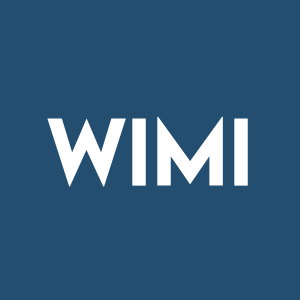WiMi Studies Hybrid Quantum-Classical Convolutional Neural Network Model
Rhea-AI Summary
WiMi Hologram Cloud (NASDAQ: WIMI) announced research into a shallow hybrid quantum-classical convolutional neural network (SHQCNN) for image classification on October 23, 2025.
The SHQCNN integrates an enhanced variational quantum method, kernel encoding for input mapping, variational quantum circuits in the hidden layer, and mini-batch gradient descent in the output layer to improve training speed, stability, accuracy, and generalization while avoiding high-depth QNN complexity.
Positive
- None.
Negative
- None.
News Market Reaction 5 Alerts
On the day this news was published, WIMI gained 5.90%, reflecting a notable positive market reaction. Our momentum scanner triggered 5 alerts that day, indicating moderate trading interest and price volatility. This price movement added approximately $2M to the company's valuation, bringing the market cap to $39M at that time.
Data tracked by StockTitan Argus on the day of publication.
BEIJING, Oct. 23, 2025 (GLOBE NEWSWIRE) -- BEIJING, Oct. 23, 2025––WiMi Hologram Cloud Inc. (NASDAQ: WiMi) ("WiMi" or the "Company"), a leading global Hologram Augmented Reality ("AR") Technology provider, today announced that they are actively exploring a shallow hybrid quantum-classical convolutional neural network (SHQCNN) model, bringing innovative breakthroughs to the field of image classification.
Variational quantum methods, as an important technical means in the field of quantum computing, provide effective pathways for the design and implementation of quantum algorithms by transforming the optimization problems of quantum states into classical optimization problems. WiMi has adopted an enhanced variational quantum method in the SHQCNN model, laying a solid foundation for the model's efficient operation in image classification tasks. The enhanced variational quantum method has undergone multi-faceted optimizations based on traditional methods. First, in terms of quantum state representation, by introducing more complex combinations of quantum gates and parameterized forms, it can more precisely describe the quantum features of image data. Second, in the optimization algorithm, advanced adaptive optimization strategies are employed, which can dynamically adjust optimization parameters based on real-time feedback during the training process, accelerating convergence speed and improving the model's training efficiency. This enhanced variational quantum method enables the SHQCNN model to fully leverage the advantages of quantum computing when handling image classification tasks, while avoiding the complexity issues brought by increasing layers in traditional QNNs.
In image classification tasks, the quality and distinguishability of input data directly affect the model's performance. The SHQCNN model adopts the kernel encoding method in the input layer; this method is like a precise key, enhancing the efficiency of data distinction and processing. The core idea of the kernel encoding method is to map the original image data from low-dimensional space to high-dimensional feature space through nonlinear mapping, making image data that is difficult to distinguish in the low-dimensional space easier to separate in the high-dimensional space. Through the kernel encoding method, the SHQCNN model optimizes the data processing at the input stage, providing high-quality input for the computations of subsequent hidden and output layers, thereby improving the classification accuracy of the entire model.
And the hidden layer, as the core part of the neural network, undertakes the important task of feature extraction and transformation of input data. In traditional QNNs, as the number of layers increases, the computational complexity of the hidden layer rises sharply, leading to the training process becoming extremely difficult. The SHQCNN model designs variational quantum circuits in the hidden layer, cleverly solving this problem. Variational quantum circuits are composed of a series of quantum gates, which can perform specific transformations on the input quantum states. Compared to the hidden layers of traditional deep neural networks, variational quantum circuits have a more concise structure and lower computational complexity. Through rationally designing the types and arrangement order of quantum gates, variational quantum circuits can achieve effective extraction of image features within fewer layers.At the same time, the parameters of the variational quantum circuit can be trained through classical optimization algorithms, enabling the model to perform adaptive optimization based on different image classification tasks, further improving the model's generalization ability.
The output layer, as the final module of the neural network, is responsible for classification decisions on the features extracted by the hidden layer. The SHQCNN model adopts the mini-batch gradient descent algorithm in the output layer; this innovative application of the algorithm brings significant improvements to the model's parameter training and learning speed. The mini-batch gradient descent algorithm is a variant of the gradient descent algorithm. In each iteration, instead of using all the training data, it randomly selects a small batch of data from the training set for computation. Compared to the traditional batch gradient descent algorithm, the mini-batch gradient descent algorithm has faster computation speed and better convergence. In the SHQCNN model, by performing weight updates more frequently, the mini-batch gradient descent algorithm can timely adjust the model's parameters, enabling the model to adapt more quickly to changes in the training data.
The shallow hybrid quantum-classical convolutional neural network model (SHQCNN) researched by WiMi, through the integrated application of a series of advanced technologies such as enhanced variational quantum methods, kernel encoding methods, variational quantum circuits, and mini-batch gradient descent algorithms, has significant advantages in terms of stability, accuracy, and generalization, and will bring new solutions to the field of image classification. With the continuous development of quantum computing technology and the continuous expansion of application scenarios, the SHQCNN model will demonstrate its enormous potential in more fields.
About WiMi Hologram Cloud
WiMi Hologram Cloud Inc. (NASDAQ: WiMi) focuses on holographic cloud services, primarily concentrating on professional fields such as in-vehicle AR holographic HUD, 3D holographic pulse LiDAR, head-mounted light field holographic devices, holographic semiconductors, holographic cloud software, holographic car navigation, metaverse holographic AR/VR devices, and metaverse holographic cloud software. It covers multiple aspects of holographic AR technologies, including in-vehicle holographic AR technology, 3D holographic pulse LiDAR technology, holographic vision semiconductor technology, holographic software development, holographic AR virtual advertising technology, holographic AR virtual entertainment technology, holographic ARSDK payment, interactive holographic virtual communication, metaverse holographic AR technology, and metaverse virtual cloud services. WiMi is a comprehensive holographic cloud technology solution provider. For more information, please visit http://ir.wimiar.com.
Translation Disclaimer
The original version of this announcement is the officially authorized and only legally binding version. If there are any inconsistencies or differences in meaning between the Chinese translation and the original version, the original version shall prevail. WiMi Hologram Cloud Inc. and related institutions and individuals make no guarantees regarding the translated version and assume no responsibility for any direct or indirect losses caused by translation inaccuracies.
Investor Inquiries, please contact:
WIMI Hologram Cloud Inc.
Email: pr@wimiar.com
ICR, LLC
Robin Yang
Tel: +1 (646) 975-9495
Email: wimi@icrinc.com








